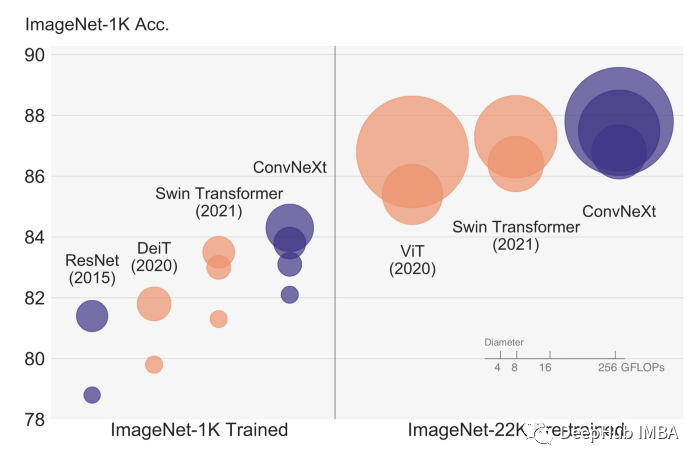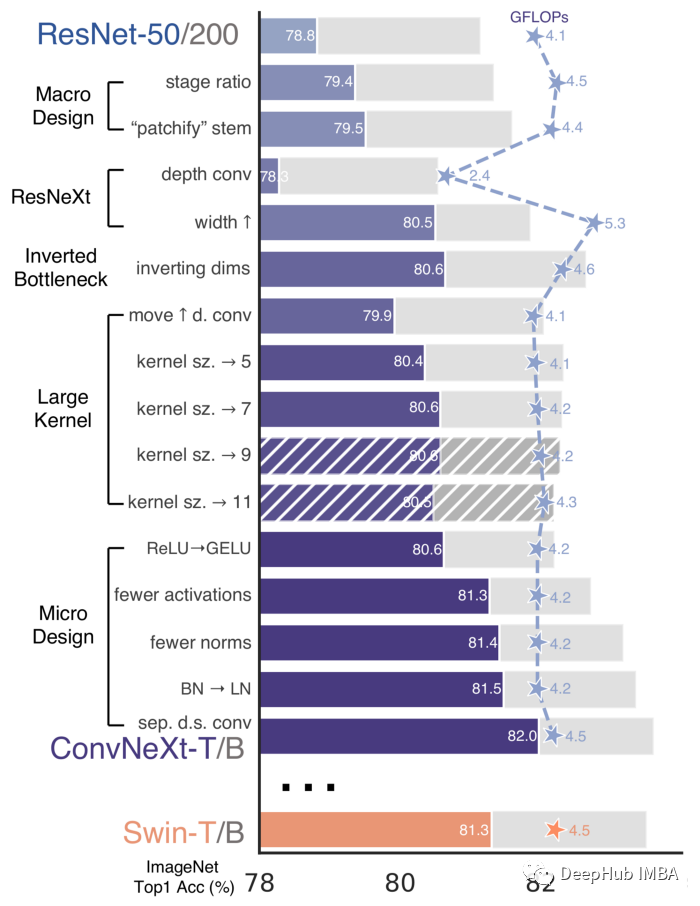[外链图片转存失败,源站可能有防盗链机制,建议将图片保存下来直接上传(img-QzSpL26A-1652067254818)(http://images.overfit.cn/upload/20220509/bbdccec911fc47e286ee2361fd9f8810.png)]
ConvNext论文提出了一种新的基于卷积的架构,不仅超越了基于 Transformer 的模型(如 Swin),而且可以随着数据量的增加而扩展!今天我们使用Pytorch来对其进行复现。下图显示了针对不同数据集/模型大小的 ConvNext 准确度。

作者首先采用众所周知的 ResNet 架构,并根据过去十年中的新最佳实践和发现对其进行迭代改进。作者专注于 Swin-Transformer,并密切关注其设计。这篇论文我们在以前也推荐过,如果你们有阅读过,我们强烈推荐阅读它:)
下图显示了所有各种改进以及每一项改进之后的各自性能。

论文将设计的路线图分为两部分:宏观设计和微观设计。宏观设计是从高层次的角度所做的所有改变,例如架构的设计,而微设计更多的是关于细节的,例如激活函数,归一化等。
下面我们将从一个经典的 BottleNeck 块开始,并使用pytorch逐个实现论文中说到的每个更改。
从ResNet开始
ResNet 由一个一个的残差(BottleNeck) 块,我们就从这里开始。
fromtorchimportnn
fromtorchimportTensor
fromtypingimportList
classConvNormAct(nn.Sequential):
"""
A little util layer composed by (conv) -> (norm) -> (act) layers.
"""
def__init__(
self,
in_features: int,
out_features: int,
kernel_size: int,
norm = nn.BatchNorm2d,
act = nn.ReLU,
**kwargs
):
super().__init__(
nn.Conv2d(
in_features,
out_features,
kernel_size=kernel_size,
padding=kernel_size//2,
**kwargs
),
norm(out_features),
act(),
)
classBottleNeckBlock(nn.Module):
def__init__(
self,
in_features: int,
out_features: int,
reduction: int = 4,
stride: int = 1,
):
super().__init__()
reduced_features = out_features//reduction
self.block = nn.Sequential(
# wide -> narrow
ConvNormAct(
in_features, reduced_features, kernel_size=1, stride=stride, bias=False
),
# narrow -> narrow
ConvNormAct(reduced_features, reduced_features, kernel_size=3, bias=False),
# narrow -> wide
ConvNormAct(reduced_features, out_features, kernel_size=1, bias=False, act=nn.Identity),
)
self.shortcut = (
nn.Sequential(
ConvNormAct(
in_features, out_features, kernel_size=1, stride=stride, bias=False
)
)
ifin_features!= out_features
elsenn.Identity()
)
self.act = nn.ReLU()
defforward(self, x: Tensor) ->Tensor:
res = x
x = self.block(x)
res = self.shortcut(res)
x += res
x = self.act(x)
returnx
看看上面代码是否有效
importtorch
x = torch.rand(1, 32, 7, 7)
block = BottleNeckBlock(32, 64)
block(x).shape
#torch.Size([1, 64, 7, 7])
下面开始定义Stage,Stage也叫阶段是残差块的集合。每个阶段通常将输入下采样 2 倍
classConvNexStage(nn.Sequential):
def__init__(
self, in_features: int, out_features: int, depth: int, stride: int = 2, **kwargs
):
super().__init__(
# downsample is done here
BottleNeckBlock(in_features, out_features, stride=stride, **kwargs),
*[
BottleNeckBlock(out_features, out_features, **kwargs)
for_inrange(depth-1)
],
)
测试
stage = ConvNexStage(32, 64, depth=2)
stage(x).shape
#torch.Size([1, 64, 4, 4])
我们已经将输入是从 7x7 减少到 4x4 。
ResNet 也有所谓的 stem,这是模型中对输入图像进行大量下采样的第一层。
classConvNextStem(nn.Sequential):
def__init__(self, in_features: int, out_features: int):
super().__init__(
ConvNormAct(
in_features, out_features, kernel_size=7, stride=2
),
nn.MaxPool2d(kernel_size=3, stride=2, padding=1),
)
现在我们可以定义 ConvNextEncoder 来拼接各个阶段,并将图像作为输入生成最终嵌入。
classConvNextEncoder(nn.Module):
def__init__(
self,
in_channels: int,
stem_features: int,
depths: List[int],
widths: List[int],
):
super().__init__()
self.stem = ConvNextStem(in_channels, stem_features)
in_out_widths = list(zip(widths, widths[1:]))
self.stages = nn.ModuleList(
[
ConvNexStage(stem_features, widths[0], depths[0], stride=1),
*[
ConvNexStage(in_features, out_features, depth)
for (in_features, out_features), depthinzip(
in_out_widths, depths[1:]
)
],
]
)
defforward(self, x):
x = self.stem(x)
forstageinself.stages:
x = stage(x)
returnx
测试结果如下:
image = torch.rand(1, 3, 224, 224)
encoder = ConvNextEncoder(in_channels=3, stem_features=64, depths=[3,4,6,4], widths=[256, 512, 1024, 2048])
encoder(image).shape
#torch.Size([1, 2048, 7, 7])
现在我们完成了 resnet50 编码器,如果你附加一个分类头,那么他就可以在图像分类任务上工作。下面开始进入本文的正题实现ConvNext。
Macro Design
1、改变阶段计算比率
传统的ResNet 中包含了 4 个阶段,而Swin Transformer这4个阶段使用的比例为1:1:3:1(第一个阶段有一个区块,第二个阶段有一个区块,第三个阶段有三个区块……)将ResNet50调整为这个比率((3,4,6,3)->(3,3,9,3))可以使性能从78.8%提高到79.4%。
encoder = ConvNextEncoder(in_channels=3, stem_features=64, depths=[3,3,9,3], widths=[256, 512, 1024, 2048])
2、将stem改为“Patchify”
ResNet stem使用的是非常激进的7x7和maxpool来大量采样输入图像。然而,Transfomers 使用了 被称为“Patchify”的主干,这意味着他们将输入图像嵌入到补丁中。Vision transforms使用非常激进的补丁(16x16),而ConvNext的作者使用使用conv层实现的4x4补丁,这使得性能从79.4%提升到79.5%。
classConvNextStem(nn.Sequential):
def__init__(self, in_features: int, out_features: int):
super().__init__(
nn.Conv2d(in_features, out_features, kernel_size=4, stride=4),
nn.BatchNorm2d(out_features)
)
3、ResNeXtify
ResNetXt 对 BottleNeck 中的 3x3 卷积层采用分组卷积来减少 FLOPS。在 ConvNext 中使用depth-wise convolution(如 MobileNet 和后来的 EfficientNet)。depth-wise convolution也是是分组卷积的一种形式,其中组数等于输入通道数。
作者注意到这与 self-attention 中的加权求和操作非常相似,后者仅在空间维度上混合信息。使用 depth-wise convs 会降低精度(因为没有像 ResNetXt 那样增加宽度),这是意料之中的毕竟提升了速度。
所以我们将 BottleNeck 块内的 3x3 conv 更改为下面代码
ConvNormAct(reduced_features, reduced_features, kernel_size=3, bias=False, groups=reduced_features)
4、Inverted Bottleneck(倒置瓶颈)
一般的 BottleNeck 首先通过 1x1 conv 减少特征,然后用 3x3 conv,最后将特征扩展为原始大小,而倒置瓶颈块则相反。
所以下面我们从宽 -> 窄 -> 宽 修改到到 窄 -> 宽 -> 窄。
这与 Transformer 类似,由于 MLP 层遵循窄 -> 宽 -> 窄设计,MLP 中的第二个稠密层将输入的特征扩展了四倍。
classBottleNeckBlock(nn.Module):
def__init__(
self,
in_features: int,
out_features: int,
expansion: int = 4,
stride: int = 1,
):
super().__init__()
expanded_features = out_features*expansion
self.block = nn.Sequential(
# narrow -> wide
ConvNormAct(
in_features, expanded_features, kernel_size=1, stride=stride, bias=False
),
# wide -> wide (with depth-wise)
ConvNormAct(expanded_features, expanded_features, kernel_size=3, bias=False, groups=in_features),
# wide -> narrow
ConvNormAct(expanded_features, out_features, kernel_size=1, bias=False, act=nn.Identity),
)
self.shortcut = (
nn.Sequential(
ConvNormAct(
in_features, out_features, kernel_size=1, stride=stride, bias=False
)
)
ifin_features!= out_features
elsenn.Identity()
)
self.act = nn.ReLU()
defforward(self, x: Tensor) ->Tensor:
res = x
x = self.block(x)
res = self.shortcut(res)
x += res
x = self.act(x)
returnx
5、扩大卷积核大小
像Swin一样,ViT使用更大的内核尺寸(7x7)。增加内核的大小会使计算量更大,所以才使用上面提到的depth-wise convolution,通过使用更少的通道来减少计算量。作者指出,这类似于 Transformers 模型,其中多头自我注意 (MSA) 在 MLP 层之前完成。
classBottleNeckBlock(nn.Module):
def__init__(
self,
in_features: int,
out_features: int,
expansion: int = 4,
stride: int = 1,
):
super().__init__()
expanded_features = out_features*expansion
self.block = nn.Sequential(
# narrow -> wide (with depth-wise and bigger kernel)
ConvNormAct(
in_features, in_features, kernel_size=7, stride=stride, bias=False, groups=in_features
),
# wide -> wide
ConvNormAct(in_features, expanded_features, kernel_size=1),
# wide -> narrow
ConvNormAct(expanded_features, out_features, kernel_size=1, bias=False, act=nn.Identity),
)
self.shortcut = (
nn.Sequential(
ConvNormAct(
in_features, out_features, kernel_size=1, stride=stride, bias=False
)
)
ifin_features!= out_features
elsenn.Identity()
)
self.act = nn.ReLU()
defforward(self, x: Tensor) ->Tensor:
res = x
x = self.block(x)
res = self.shortcut(res)
x += res
x = self.act(x)
returnx
这将准确度从 79.9% 提高到 80.6%
Micro Design
1、用 GELU 替换 ReLU
transformers使用的是GELU,为什么我们不用呢?作者测试替换后准确率保持不变。PyTorch 的GELU 是 在 nn.GELU。
2、更少的激活函数
残差块有三个激活函数。而在Transformer块中,只有一个激活函数,即MLP块中的激活函数。作者除去了除中间层之后的所有激活。这是与swing - t一样的,这使得精度提高到81.3% !
3、更少的归一化层
与激活类似,Transformers 块具有较少的归一化层。作者决定删除所有 BatchNorm,只保留中间转换之前的那个。
4、用 LN 代替 BN
作者用 LN代替了 BN层。他们注意到在原始 ResNet 中提到这样做会损害性能,但经过作者以上的所有的更改后,性能提高到 81.5%
上面4个步骤让我们整合起来操作:
classBottleNeckBlock(nn.Module):
def__init__(
self,
in_features: int,
out_features: int,
expansion: int = 4,
stride: int = 1,
):
super().__init__()
expanded_features = out_features*expansion
self.block = nn.Sequential(
# narrow -> wide (with depth-wise and bigger kernel)
nn.Conv2d(
in_features, in_features, kernel_size=7, stride=stride, bias=False, groups=in_features
),
# GroupNorm with num_groups=1 is the same as LayerNorm but works for 2D data
nn.GroupNorm(num_groups=1, num_channels=in_features),
# wide -> wide
nn.Conv2d(in_features, expanded_features, kernel_size=1),
nn.GELU(),
# wide -> narrow
nn.Conv2d(expanded_features, out_features, kernel_size=1),
)
self.shortcut = (
nn.Sequential(
ConvNormAct(
in_features, out_features, kernel_size=1, stride=stride, bias=False
)
)
ifin_features!= out_features
elsenn.Identity()
)
defforward(self, x: Tensor) ->Tensor:
res = x
x = self.block(x)
res = self.shortcut(res)
x += res
returnx
分离下采样层
在 ResNet 中,下采样是通过 stride=2 conv 完成的。Transformers(以及其他卷积网络)也有一个单独的下采样模块。作者删除了 stride=2 并在三个 conv 之前添加了一个下采样块,为了保持训练期间的稳定性在,在下采样操作之前需要进行归一化。将此模块添加到 ConvNexStage。达到了超过 Swin 的 82.0%!
classConvNexStage(nn.Sequential):
def__init__(
self, in_features: int, out_features: int, depth: int, **kwargs
):
super().__init__(
# add the downsampler
nn.Sequential(
nn.GroupNorm(num_groups=1, num_channels=in_features),
nn.Conv2d(in_features, out_features, kernel_size=2, stride=2)
),
*[
BottleNeckBlock(out_features, out_features, **kwargs)
for_inrange(depth)
],
)
现在我们得到了最终的 BottleNeckBlock层代码:
classBottleNeckBlock(nn.Module):
def__init__(
self,
in_features: int,
out_features: int,
expansion: int = 4,
):
super().__init__()
expanded_features = out_features*expansion
self.block = nn.Sequential(
# narrow -> wide (with depth-wise and bigger kernel)
nn.Conv2d(
in_features, in_features, kernel_size=7, padding=3, bias=False, groups=in_features
),
# GroupNorm with num_groups=1 is the same as LayerNorm but works for 2D data
nn.GroupNorm(num_groups=1, num_channels=in_features),
# wide -> wide
nn.Conv2d(in_features, expanded_features, kernel_size=1),
nn.GELU(),
# wide -> narrow
nn.Conv2d(expanded_features, out_features, kernel_size=1),
)
defforward(self, x: Tensor) ->Tensor:
res = x
x = self.block(x)
x += res
returnx
让我们测试一下最终的stage代码
stage = ConvNexStage(32, 62, depth=1)
stage(torch.randn(1, 32, 14, 14)).shape
#torch.Size([1, 62, 7, 7])
最后的一些丢该
论文中还添加了Stochastic Depth,也称为 Drop Path还有 Layer Scale。
fromtorchvision.opsimportStochasticDepth
classLayerScaler(nn.Module):
def__init__(self, init_value: float, dimensions: int):
super().__init__()
self.gamma = nn.Parameter(init_value*torch.ones((dimensions)),
requires_grad=True)
defforward(self, x):
returnself.gamma[None,...,None,None] *x
classBottleNeckBlock(nn.Module):
def__init__(
self,
in_features: int,
out_features: int,
expansion: int = 4,
drop_p: float = .0,
layer_scaler_init_value: float = 1e-6,
):
super().__init__()
expanded_features = out_features*expansion
self.block = nn.Sequential(
# narrow -> wide (with depth-wise and bigger kernel)
nn.Conv2d(
in_features, in_features, kernel_size=7, padding=3, bias=False, groups=in_features
),
# GroupNorm with num_groups=1 is the same as LayerNorm but works for 2D data
nn.GroupNorm(num_groups=1, num_channels=in_features),
# wide -> wide
nn.Conv2d(in_features, expanded_features, kernel_size=1),
nn.GELU(),
# wide -> narrow
nn.Conv2d(expanded_features, out_features, kernel_size=1),
)
self.layer_scaler = LayerScaler(layer_scaler_init_value, out_features)
self.drop_path = StochasticDepth(drop_p, mode="batch")
defforward(self, x: Tensor) ->Tensor:
res = x
x = self.block(x)
x = self.layer_scaler(x)
x = self.drop_path(x)
x += res
returnx
好了,现在我们看看最终结果
stage = ConvNexStage(32, 62, depth=1)
stage(torch.randn(1, 32, 14, 14)).shape
#torch.Size([1, 62, 7, 7])
最后我们修改一下Drop Path的概率
classConvNextEncoder(nn.Module):
def__init__(
self,
in_channels: int,
stem_features: int,
depths: List[int],
widths: List[int],
drop_p: float = .0,
):
super().__init__()
self.stem = ConvNextStem(in_channels, stem_features)
in_out_widths = list(zip(widths, widths[1:]))
# create drop paths probabilities (one for each stage)
drop_probs = [x.item() forxintorch.linspace(0, drop_p, sum(depths))]
self.stages = nn.ModuleList(
[
ConvNexStage(stem_features, widths[0], depths[0], drop_p=drop_probs[0]),
*[
ConvNexStage(in_features, out_features, depth, drop_p=drop_p)
for (in_features, out_features), depth, drop_pinzip(
in_out_widths, depths[1:], drop_probs[1:]
)
],
]
)
defforward(self, x):
x = self.stem(x)
forstageinself.stages:
x = stage(x)
returnx
测试:
image = torch.rand(1, 3, 224, 224)
encoder = ConvNextEncoder(in_channels=3, stem_features=64, depths=[3,4,6,4], widths=[256, 512, 1024, 2048])
encoder(image).shape
#torch.Size([1, 2048, 3, 3])
ConvNext的特征,我们需要在编码器顶部应用分类头。我们还在最后一个线性层之前添加了一个 LayerNorm。
classClassificationHead(nn.Sequential):
def__init__(self, num_channels: int, num_classes: int = 1000):
super().__init__(
nn.AdaptiveAvgPool2d((1, 1)),
nn.Flatten(1),
nn.LayerNorm(num_channels),
nn.Linear(num_channels, num_classes)
)
classConvNextForImageClassification(nn.Sequential):
def__init__(self,
in_channels: int,
stem_features: int,
depths: List[int],
widths: List[int],
drop_p: float = .0,
num_classes: int = 1000):
super().__init__()
self.encoder = ConvNextEncoder(in_channels, stem_features, depths, widths, drop_p)
self.head = ClassificationHead(widths[-1], num_classes)
最终模型测试:
image = torch.rand(1, 3, 224, 224)
classifier = ConvNextForImageClassification(in_channels=3, stem_features=64, depths=[3,4,6,4], widths=[256, 512, 1024, 2048])
classifier(image).shape
#torch.Size([1, 1000])
最后总结
在本文中复现了作者使用ResNet 创建ConvNext 的所有过程。 如果你想需要完整代码,可以查看这个地址:
https://avoid.overfit.cn/post/1fd17e7520134996b532ecd50de9672f
作者:Francesco Zuppichini
